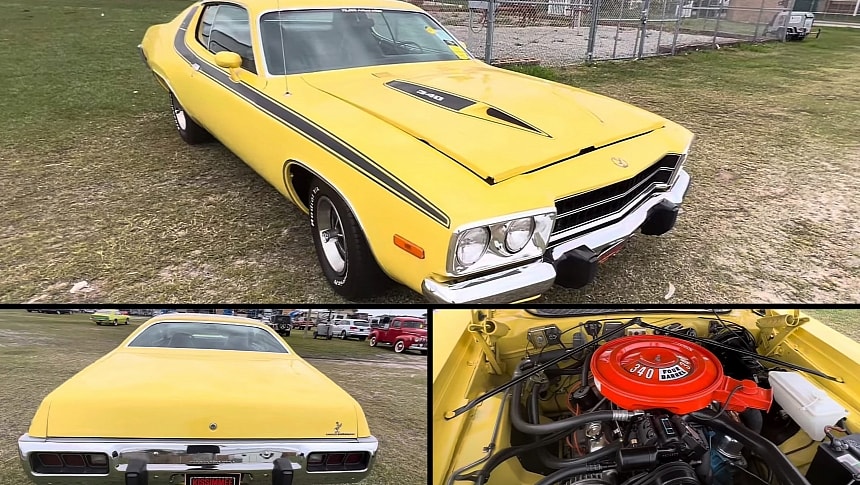The jury is still out on when the golden muscle car era came to an end, but to most Mopar enthusiasts, it happened in 1971. That was the final year for Chrysler's high-compression big-block V8 engines, which included the iconic 440-cubic-inch (7.2-liter) RB and the 426-cubic-inch (7.0-liter) HEMI. And that's one of the reasons why many 1972-1974 Dodges and Plymouth don't get as much love as their predecessors.
All told I know a lot of people who wouldn't be caught dead in a late third-gen Dodge Charger or second-gen Plymouth Road Runner. But once you get over the lack of a 440 Six-Pack or a 426 HEMI, these cars aren't all that bad. And this 1973 Road Runner is proof that post-1971 Mopars can age gracefully with proper maintenance.
Granted, this Road Runner is way too clean to be an all-original survivor, but it's still amazing that it has been restored like this. Most of these Mopars are usually left to rot away in junkyards and barns simply because the restoration costs exceed the market value. However, this car has been with the same owner since 1982 (that's 42 years as of 2024), so we're looking at a labor of love. And one very lucky Road Runner.
But while the paint may not be original, the sheet metal is. The same goes for the black interior and the 340-cubic-inch (5.6-liter) V8 under the hood. Rated at 240 net horsepower, this mill slotted between the base 318-cubic-inch (5.2-liter) and the 400-cubic-inch (6.6-liter) V8s. While the former delivered 170 horses, the latter came with 260 horsepower on tap. Plymouth also offered a four-barrel 440 V8 good for 280 horses that year.
The 340 was the second-most common powerplant in the 1973 Road Runner. Of the 15,929 units built that year, 5,384 were optioned up with the small block. This specific car is automatic, so it's actually one of 4,428 examples with this drivetrain combo. Far from rare, I guess.
But there's one thing that makes it special: this Mopar rocks an FY1 Lemon Twist paint. Part of the iconic High-Impact color palette, Lemon Twist (or Top Banana on Dodge vehicles) became available in 1970 and remained on the options list for four years. This makes it the longest-running High-Impact hue alongside Tor Red/HEMI Orange. More importantly, it was the only High-Impact paint available in 1973 and the last one Chrysler offered in the 1970s. All told this Road Runner is one of the last B-body vehicles ordered in such a color.
Granted, it's not the kind of feature that makes it more desirable, but it's an interesting fact. And it could also be a great conversation starter at the local car show. It probably doesn't have much to do with the Lemon Twist paint, but this Road Runner became one of the most expensive of its kind, having changed hands for $44,000 (including fees) at Kissimmee 2024.
Granted, this Road Runner is way too clean to be an all-original survivor, but it's still amazing that it has been restored like this. Most of these Mopars are usually left to rot away in junkyards and barns simply because the restoration costs exceed the market value. However, this car has been with the same owner since 1982 (that's 42 years as of 2024), so we're looking at a labor of love. And one very lucky Road Runner.
But while the paint may not be original, the sheet metal is. The same goes for the black interior and the 340-cubic-inch (5.6-liter) V8 under the hood. Rated at 240 net horsepower, this mill slotted between the base 318-cubic-inch (5.2-liter) and the 400-cubic-inch (6.6-liter) V8s. While the former delivered 170 horses, the latter came with 260 horsepower on tap. Plymouth also offered a four-barrel 440 V8 good for 280 horses that year.
The 340 was the second-most common powerplant in the 1973 Road Runner. Of the 15,929 units built that year, 5,384 were optioned up with the small block. This specific car is automatic, so it's actually one of 4,428 examples with this drivetrain combo. Far from rare, I guess.
But there's one thing that makes it special: this Mopar rocks an FY1 Lemon Twist paint. Part of the iconic High-Impact color palette, Lemon Twist (or Top Banana on Dodge vehicles) became available in 1970 and remained on the options list for four years. This makes it the longest-running High-Impact hue alongside Tor Red/HEMI Orange. More importantly, it was the only High-Impact paint available in 1973 and the last one Chrysler offered in the 1970s. All told this Road Runner is one of the last B-body vehicles ordered in such a color.
Granted, it's not the kind of feature that makes it more desirable, but it's an interesting fact. And it could also be a great conversation starter at the local car show. It probably doesn't have much to do with the Lemon Twist paint, but this Road Runner became one of the most expensive of its kind, having changed hands for $44,000 (including fees) at Kissimmee 2024.
















